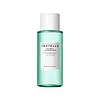What's inside
What's inside
 Key Ingredients
Key Ingredients

 Benefits
Benefits

 Concerns
Concerns

 Ingredients Side-by-side
Ingredients Side-by-side

Water
Skin ConditioningMethyl Gluceth-20
HumectantAlcohol
AntimicrobialNiacinamide
SmoothingButylene Glycol
HumectantBeta-Glucan
Skin ConditioningGlycerin
HumectantBetaine
HumectantAcrylates/C10-30 Alkyl Acrylate Crosspolymer
Emulsion StabilisingTriethanolamine
BufferingAllantoin
Skin ConditioningColloidal Sulfur
AntimicrobialChlorphenesin
AntimicrobialZanthoxylum Piperitum Fruit Extract
Skin ConditioningPulsatilla Koreana Extract
Skin ConditioningUsnea Barbata Extract
Adenosine
Skin ConditioningSalvia Sclarea Extract
AntiseborrhoeicHyacinthus Orientalis Extract
Skin ConditioningPropanediol
SolventEDTA
Zingiber Officinale Root Extract
MaskingCamellia Japonica Leaf Extract
Skin ConditioningSalicylic Acid
MaskingPhellodendron Amurense Bark Extract
Skin ConditioningCitrus Paradisi Seed Extract
MaskingMagnolia Officinalis Bark Extract
AntimicrobialSophora Angustifolia Root Extract
Skin ConditioningCitrus Paradisi Fruit Extract
Skin Conditioning1,2-Hexanediol
Skin ConditioningSalix Alba Bark Extract
AstringentBenzyl Alcohol
PerfumingLavandula Angustifolia Water
MaskingBorago Officinalis Extract
EmollientChamomilla Recutita Flower/Leaf Extract
AntimicrobialCentaurea Cyanus Flower Extract
AstringentOvalicin
AntimicrobialEthylhexylglycerin
Skin ConditioningMelaleuca Alternifolia Leaf Oil
AntioxidantWater, Methyl Gluceth-20, Alcohol, Niacinamide, Butylene Glycol, Beta-Glucan, Glycerin, Betaine, Acrylates/C10-30 Alkyl Acrylate Crosspolymer, Triethanolamine, Allantoin, Colloidal Sulfur, Chlorphenesin, Zanthoxylum Piperitum Fruit Extract, Pulsatilla Koreana Extract, Usnea Barbata Extract, Adenosine, Salvia Sclarea Extract, Hyacinthus Orientalis Extract, Propanediol, EDTA, Zingiber Officinale Root Extract, Camellia Japonica Leaf Extract, Salicylic Acid, Phellodendron Amurense Bark Extract, Citrus Paradisi Seed Extract, Magnolia Officinalis Bark Extract, Sophora Angustifolia Root Extract, Citrus Paradisi Fruit Extract, 1,2-Hexanediol, Salix Alba Bark Extract, Benzyl Alcohol, Lavandula Angustifolia Water, Borago Officinalis Extract, Chamomilla Recutita Flower/Leaf Extract, Centaurea Cyanus Flower Extract, Ovalicin, Ethylhexylglycerin, Melaleuca Alternifolia Leaf Oil
Water
Skin ConditioningChamaecyparis Obtusa Water
MaskingMelaleuca Alternifolia Leaf Water
AntimicrobialButylene Glycol
HumectantCentella Asiatica Extract
CleansingPropanediol
SolventPinus Palustris Leaf Extract
TonicMethyl Gluceth-20
Humectant1,2-Hexanediol
Skin ConditioningHydroxyacetophenone
AntioxidantCarbomer
Emulsion StabilisingPolyglyceryl-10 Laurate
Skin ConditioningTromethamine
BufferingPentylene Glycol
Skin ConditioningEthylhexylglycerin
Skin ConditioningCaprylyl Glycol
EmollientCitric Acid
BufferingDisodium EDTA
Melaleuca Alternifolia Leaf Oil
AntioxidantSodium Citrate
BufferingSalicylic Acid
MaskingCastanea Crenata Shell Extract
Skin ConditioningLavandula Angustifolia Flower Extract
CleansingWater, Chamaecyparis Obtusa Water, Melaleuca Alternifolia Leaf Water, Butylene Glycol, Centella Asiatica Extract, Propanediol, Pinus Palustris Leaf Extract, Methyl Gluceth-20, 1,2-Hexanediol, Hydroxyacetophenone, Carbomer, Polyglyceryl-10 Laurate, Tromethamine, Pentylene Glycol, Ethylhexylglycerin, Caprylyl Glycol, Citric Acid, Disodium EDTA, Melaleuca Alternifolia Leaf Oil, Sodium Citrate, Salicylic Acid, Castanea Crenata Shell Extract, Lavandula Angustifolia Flower Extract
 Reviews
Reviews

Ingredients Explained
These ingredients are found in both products.
Ingredients higher up in an ingredient list are typically present in a larger amount.
1,2-Hexanediol is a synthetic liquid and another multi-functional powerhouse.
It is a:
- Humectant, drawing moisture into the skin
- Emollient, helping to soften skin
- Solvent, dispersing and stabilizing formulas
- Preservative booster, enhancing the antimicrobial activity of other preservatives
Butylene Glycol (or BG) is used within cosmetic products for a few different reasons:
Overall, Butylene Glycol is a safe and well-rounded ingredient that works well with other ingredients.
Though this ingredient works well with most skin types, some people with sensitive skin may experience a reaction such as allergic rashes, closed comedones, or itchiness.
Learn more about Butylene GlycolEthylhexylglycerin (we can't pronounce this either) is commonly used as a preservative and skin softener. It is derived from glyceryl.
You might see Ethylhexylglycerin often paired with other preservatives such as phenoxyethanol. Ethylhexylglycerin has been found to increase the effectiveness of these other preservatives.
This tea tree oil comes from the leaves of the Tea Tree plant. Tea tree oil has antioxidant, anti-inflammatory, and antimicrobial properties.
According to the book Journal of Profiles of Drug Substances, tea tree helps in reducing acne-causing bacteria such as Propionibacterium acnes. This is due to the Terpinen components of tea tree oil.
Tea tree may cause sensitivity and irritation for some people. This oil naturally contains fragrance such as linalool and limonene.
However, research shows irritation usually occurs when using pure tea tree oil and not in cosmetic products.
Tea tree oil was found to help relieve the symptoms of psoriasis in one study.
Tea tree oil is toxic when ingested. Another study showed it to caused damage to the nervous system of dogs and cats when applied to their skin or given orally.
Learn more about Melaleuca Alternifolia Leaf OilMethyl Gluceth-20 is a humectant. Humectants help draw moisture from the air to your skin.
It is created by combining polyethylene glycol with glucose.
Propanediol is an all-star ingredient. It softens, hydrates, and smooths the skin.
It’s often used to:
Propanediol is not likely to cause sensitivity and considered safe to use. It is derived from corn or petroleum with a clear color and no scent.
Learn more about PropanediolSalicylic Acid (also known as beta hydroxy acid or BHA) is a well-known ingredient for treating skin that struggles with acne and clogged pores. It exfoliates both the skin's surface and deep within the pores to help clear out buildup, control oil, and reduce inflammation.
Unlike AHAs (alpha hydroxy acids), salicylic acid is oil-soluble. This allows it to penetrate into pores which makes it especially effective for treating blackheads and preventing future breakouts.
Salicylic acid is also known for its soothing properties. It has a similar structure to aspirin and can calm inflamed or irritated skin, making it a good option for acne-prone skin that is also sensitive.
Concentrations of 0.5-2% are recognized by the U.S. FDA as an over-the-counter topical acne product.
It can cause irritation and/or dryness if one's skin already has a compromised moisture barrier, so it's best to focus on repairing that before introducing this ingredient into your routine.
While salicylic acid does not increase sun sensitivity, it’s still important to wear sunscreen daily to protect your skin.
If you are looking for the ingredient called BHA or Butylated Hydroxyanisole, click here.
Learn more about Salicylic AcidWater. It's the most common cosmetic ingredient of all. You'll usually see it at the top of ingredient lists, meaning that it makes up the largest part of the product.
So why is it so popular? Water most often acts as a solvent - this means that it helps dissolve other ingredients into the formulation.
You'll also recognize water as that liquid we all need to stay alive. If you see this, drink a glass of water. Stay hydrated!
Learn more about Water